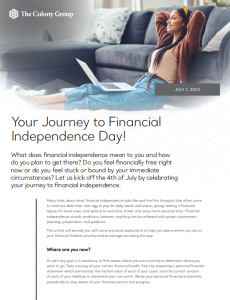Your Journey to Financial Independence Day!
What does financial independence mean to you and how do you plan to get there? Do you feel financially free right now or do you feel stuck or bound by your immediate circumstances? Let us kick off the 4th of July by celebrating your journey to financial independence.
Many think about what financial independence looks like and the first thoughts that often come to mind are debt free; nest egg to pay for daily needs and wants; giving; leaving a financial legacy for loved ones; and options to work less, travel, and enjoy more personal time. Financial independence sounds ambitious; however, anything can be achieved with proper assessment, planning, preparation, and guidance.
This article will provide you with some practical applications to help you assess where you are on your financial freedom journey and encourage you along the way.
Where are you now? As with any goal, it is necessary to first assess where you are currently to determine where you want to go. Take a survey of your current financial health. Start by preparing a personal financial statement which summarizes the market value of each of your assets and the current amount of each of your liabilities to determine your net worth. Revise your personal financial statements periodically to stay aware of your financial picture and progress.
What are your goals? Take inventory of your short and long-term financial goals; things you want to accomplish in 1 to 5 years and in 5 or more years. Some goals could be paying off your mortgage, buying your dream home or car, retiring early, taking an expensive excursion, starting a business, paying for your kids or grandkids to attend college, or being generous with philanthropic endeavors. Depending on where you are on your journey, these could be short or long-term goals. Your goals are personal and reflect your values, hopes, and dreams. Documenting your goals gives them life, so make them specific and measurable.
Create a financial plan. Now that you have identified your financial goals, establish a financial plan to achieve them. The golden rule: spend less than you earn. Create a spending plan and follow it. You will know when you are on track by recording your income and expenditures. Spending plans can be valuable and do not have to entail an exorbitant amount of accounting; there are many simple online applications that you can use and access from your personal electronic devices or a simple excel spreadsheet will also do the job. If you have a surplus or a deficit in your spending plan, you should adjust where necessary to create or increase your surplus:
- Increase your earnings. Consider seeking job promotions or even an additional part-time job. Use your talents, skills, and passions to start a business endeavor to make more money.
- Set a goal to increase savings; saving is best practice. Think about the example of the ants; they are one of the tiniest creatures on earth and they work tirelessly to store up and save their food during the summer months to prepare for the winter. You too should work tirelessly to store up savings on your journey to financial independence. Establish an emergency savings account starting with 3 to 6 months of living expenses to provide a cushion for unexpected expenditures that can arise, such as home or car repairs, loss of employment, uncovered medical expense, etc.
- Maximize your retirement contributions. Take full advantage of your company’s match; it is free money so do not leave it on the table.
- Consider investing in a college savings plan to fund your children’s education.
- Allocate some of your savings toward investment vehicles that can grow in value over time. Build wealth by diversifying your savings and investment strategies and do not put all your eggs in one basket.
- Eliminate debt. Debt feels like a burden to many and can prevent one’s feeling of financial freedom. But you can be debt free. Create a debt repayment schedule which lists all your loans balances, monthly payments, and due dates. Use the snowball strategy to pay off debt. The snowball method focuses on accelerating the payments on your smallest debt first, while making minimum payments on your other loan balances. If you have multiple loans with similar balances, pay off the debt with the highest interest rate first. After the first debt is paid off apply that payment towards the next smallest debt; after that next loan is paid, repeat until you are debt free. For auto loans, try to keep your car for several years after your car loan is paid off, but continue to pay yourself the car note in a separate account. When you are ready to purchase another car, you can use the trade-in value of your old car plus the funds you saved to pay for your next car. When you receive a windfall or unexpected cash like a tax refund or bonus at work, apply it towards your debt.
Life happens and circumstances change, so you should re-evaluate your financial plan periodically. Track your progress and mark your milestones as you achieve them.
When should you seek a professional advisor? You may need guidance in some of the areas discussed above. Whether it is financial planning, investing, or even starting your own business, it is wise to seek the advice of an experienced professional who can offer insight, alternatives, and instruction to help you meet your goals as you travel along your path to financial freedom. You would consult a medical specialist for an area of concern with your physical health, so why not consult an expert regarding concerns with your financial health? You do not have to go through your journey alone.
No matter where you are on your financial journey, steady plodding can yield the fruits of prosperity over time. Be encouraged to pursue your financial freedom no matter where you are on your life’s journey. Be intentional and methodical about setting your goals and creating a plan to achieve them. Be empowered to seek the wisdom of others to guide and support you along the way. Reach your personal destination to financial independence.
Happy Independence Day!


